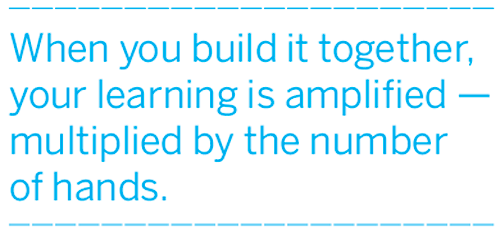
I have a friend who started using the term DIT (“do it together”) instead of DIY, and I love the notion. It’s a rare project that’s completely DIY, and certainly the projects that are the most fun involve collaboration — even if it’s just with the cranky old guy at the hardware store who ties your whole project together with some piece of ancient wisdom that should have been obvious but wasn’t.
I’ve been building an attic playspace for my toddler recently. What I really mean is we’ve been building it. At least a dozen friends and family have contributed, from framing the space to painting murals to building a ladder. What’s beautiful is how much everyone has enjoyed being part of the build. Sure, they get paid in tea, cookies, and cold beer (the currencies of DIT), but they also look forward to sharing the space with us in the future. When unexpected visitors drop by, I enlist them and they accept with gratitude. It is indeed a nice day to whitewash the fence.
It’s like barn raising. Hundreds of years ago, this is the way many things were built — by depending on each other, investing in our community through shouldering a fair load. My own culture (Australian) still idealizes the notion of “mateship”: sticking together through thick and thin, leaning on one another when there’s hard “yakka” (work) to do.
It’s astonishing how much easier hard yakka is when you’re doing it with friends. My wife has about 50 cousins (no, really), and at family events there’s never a shortage of labor. This swarm of young people seems to compete to see who can get the most work done in the shortest time. That’s the beauty of barn raising — our social drive to display our prowess is engaged, and stuff gets done quickly with smiles and laughs.
Makers are starting their own groups, collectives, and makerspaces all over the world. We’re feeling the high of DIT. Everyone can contribute time, skills, or even just muscle, knowing it will be paid back at the end of the metaphorical day.
An ancillary benefit is learning. When you make something alone, you’re learning by yourself, through books or a search engine. When you build it together, your learning is amplified. Subtle things are absorbed: a better way to swing a hammer, to finish a routing job, to solder tiny surface-mount components. Everyone on the job site has a unique set of skills, and the amount to be learned is multiplied by the number of hands.
There’s a lot that needs fixing and a lot that needs building. In cities, I see so much unused and unloved space: abandoned lots, rotting industrial buildings. I hope we find ways to reclaim these spaces. I suspect they wouldn’t take much to revamp into gardens and community centers, places we want to be. They just need some barn-raising love.
That may be hippie heresy, but hey — the social, economic, and political rules are changing. Why don’t we exploit the moment and build the future we want together? We have the best tools in history for social organization (thanks, Twitter; thanks, Facebook). Let’s apply them to the places around us. Let’s invest collectively in our infrastructure. Do your friends a favor — raise a barn, and involve them.
Saul Griffith is a new father, entrepreneur, and regular columnist for MAKE magazine. otherlab.com
This column first appeared in MAKE Volume 26 (April 2011), on page 27.
From the Pages of MAKE:
MAKE Volume 26: Karts & Wheels
Garage go-kart building is a time-honored tradition for DIYers, In this issue of MAKE, we’ll show you how to build wheeled wonders that’ll have you and the kids racing around the neighborhood in epic DIY style. Build a longboard skateboard by bending plywood and build a crazy go-kart driven by a pair of battery-powered drills. Put a mini gasoline engine on a bicycle. And construct an amazing wind-powered cart that can outrun a tailwind. Plus you’ll learn how to build the winning vehicle from our online Karts and Wheels contest! In addition to karts, you’ll find plenty of other projects that only MAKE can offer!
ADVERTISEMENT









